Abstract
We extend a model developed by Evans and Jovanovic (1989) to explain when start-ups are credit constrained. We show that the magnitude of the credit constraint is conditioned by the relative productivity of human capital in both wage work and self-employment. The effect of predicted household income on start-up capital is used to indicate the existence of financial constraint. Empirical analysis reveals that entrepreneurs with high human capital have both greater financial wealth and greater levels of start-up capital pointing to the endogenous nature of credit constraints. High human capital relaxes financial constraints, apparently due to greater productivity of human capital in wage work than in self-employment. Those who are the least likely to be credit constrained in self-employment are those that are least likely to switch into self-employment,and vice versa.
Similar content being viewed by others
References
Arabsheibani, G, D. de Meza, J. Maloney and B. Pearson, 2000), ‘And a Vision Appeared Unto them of a Great Profit: Evidence of Self-Deception among the Self-Employed’, Economics Letters 67, 35–41.
Åstebro, T. and I. Bernhardt, 2003, ‘Start-Up Financing, Owner Characteristics and Survival’, Journal of Economics and Business 55, 303–319.
Bates, T., 1990, ‘Entrepreneur Human Capital Inputs and Small Business Longevity’, Review of Economics and Statistics, 551–559.
Bernhardt, I., 1994, ‘Comparative Advantage in Self-Employment and Paid Work’, Canadian Journal of Economics 27, 273–289.
Blanchflower, D. G. and A. J. Oswald, 1998, ‘What Makes a Young Entrepreneur?’, Journal of Labor Economics 16, 26–60.
Cressy, R., 1996, ‘Are Business Startups Debt-Rationed?’, The Economic Journal 106, 1253–1270.
De Meza, D. and C. Southey, 1996, ‘The Borrower’s Curse: Optimism Finance and Entrepreneurship’, The Economic Journal 106, 375–386.
Dunn, T. and D. Holtz-Eakin, 2000, ‘Financial Capital, Human Capital and the Transition to Self-Employment: Evidence from Intergenerational Links’, Journal of Labour Economics 18, 282–305.
Evans, D. S. and B. Jovanovic, 1989, ‘An Estimated Model of Entrepreneurial Choice Under Liquidity Constraints’, Journal of Political Economy 97, 808–827.
Evans, D. S. and L. S. Leighton, 1989, ‘Some Empirical Aspects of Entrepreneurship’, American Economic Review 79, 519–535.
Grown, C. and T. Bates, 1991, ‘Commercial Bank Lending Practices and the Development of Black-owned Construction Companies’, CES Working Paper 91-9, Washington D.C.: Center for Economics Studies, 1991.
Hamilton, B. H., 2000, ‘Do Entrepreneurship Pay? An Empirical Analysis of the Returns to Self-Employment’, Journal of Political Economy 108, 604–631.
Holt, D., T. M. F. Smith and P. D. Winter, 1980, ‘Regression Analysis of Data from Complex Surveys’, Journal of the Royal Statistical Society (series A) 143, 474–487.
Holtz-Eakin, D., D. Joulfaian and H. S. Rosen, 1994a, ‘Sticking It Out: Entrepreneurial Survival and Liquidity Constraints’, Journal of Political Economy 102, 53–75.
Holtz-Eakin, D., 1994b, ‘Entrepreneurial Decisions and Liquidity Constraints’, RAND Journal of Economics 25, 334–347.
Jaffee, D. and T. Russel, 1976, ‘Imperfect Information, Uncertainty, and Credit Rationing’, Quarterly Journal of Economics 90, 651–666.
Nucci, Alfred, ‘The Characteristics of Business Owners Database’, Center for Economic Studies, U. S. Bureau of the Census, Discussion Paper CES 92-7.
Price Waterhouse LLP, 1996, ‘National Survey of Small Business Finance: Methodology Report’, available from the Federal Reserve Board’s web-site: http://www.bog.frb.fed.us/pubs/oss/
Stiglitz, Joseph E. and Andrew Weiss 1981, ‘Credit Rationing in Markets with Imperfect Information’, American Economic Review 71, 393–410.
U. S. Bureau of the Census, Characteristics of Business Owners, 1987 Economic Censuses CBO87-1, Washington, D.C. 1991.
Wolken, John D., 1998, ‘“New” Data Sources for Research on Small Business Finance’, Journal of Banking and Finance 22, 1067–1076.
Xu, Bin, 1998, ‘A Re-estimation of the Evans-Jovanovic Entrepreneurial Choice Model’, Economic Letters 58, 91–95.
Author information
Authors and Affiliations
Corresponding author
Rights and permissions
About this article
Cite this article
Åstbro, T., Bernhardt, I. The Winner’s Curse of Human Capital. Small Bus Econ 24, 63–78 (2005). https://doi.org/10.1007/s11187-005-3097-y
Accepted:
Issue Date:
DOI: https://doi.org/10.1007/s11187-005-3097-y




